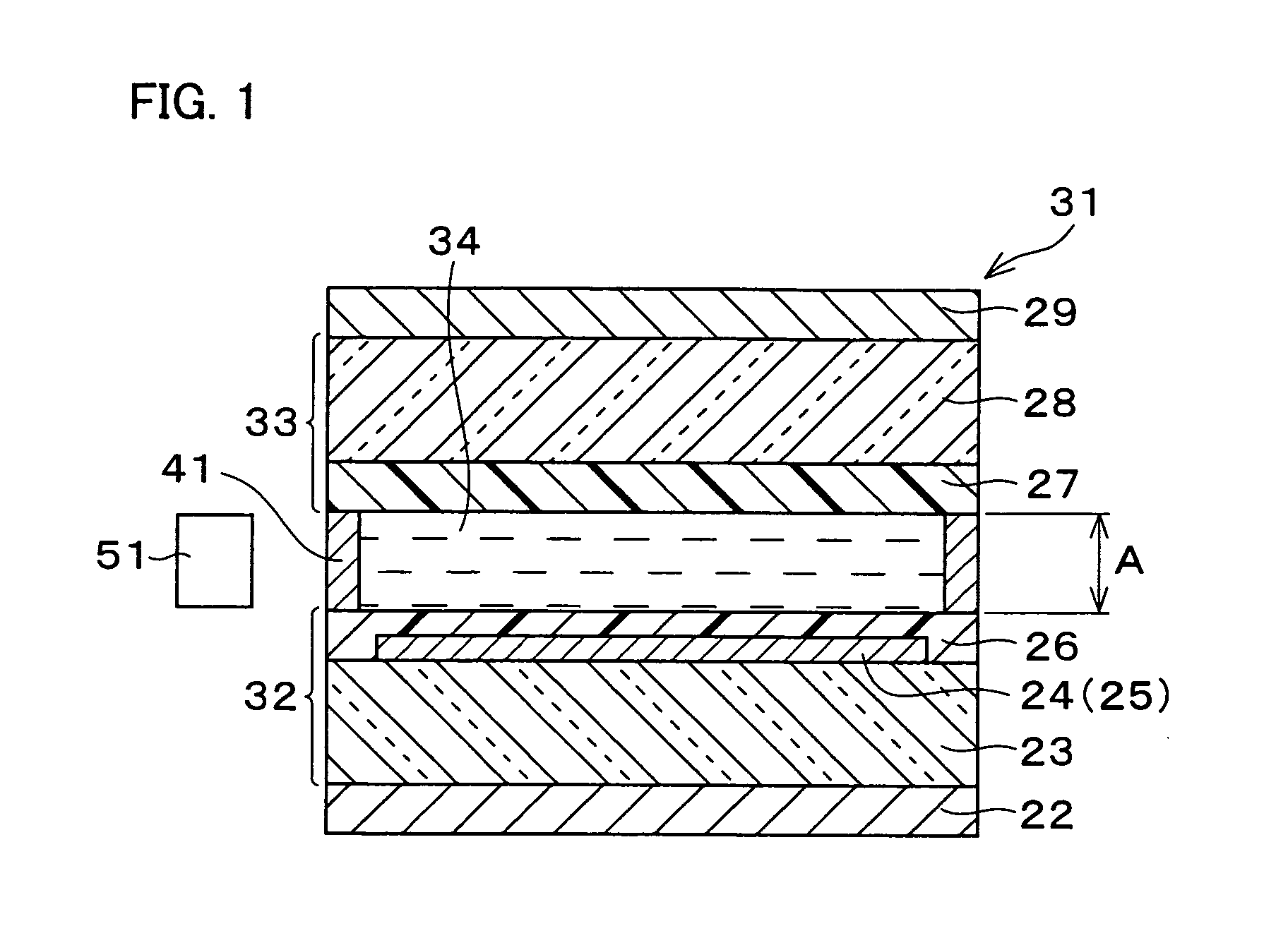Display apparatus
a technology of display apparatus and display screen, which is applied in the direction of chemistry apparatus and processes, instruments, liquid crystal compositions, etc., can solve the problem of very fast response speed of display screen apparatus of this arrangement, and achieve the effect of small temperature dependence and easy manufacturing
- Summary
- Abstract
- Description
- Claims
- Application Information
AI Technical Summary
Benefits of technology
Problems solved by technology
Method used
Image
Examples
example 1
Prepared was a mixture containing (i) 20.7 parts by weight of 4-n-hexyloxybenzoic acid represented by Formula (1), (ii) 29.3 parts by weight of 4-(4-octyloxyphenylethynyl)pyridine represented by Formula (2), and (iii) 50 parts by weight of an equal-amount mixture (hereinafter, an equal-amount mixture (I)) containing, in equal amounts, p-butoxybenzylidene-cyanoanilline represented by Formula (15), p-hexyloxybenzylidene-cyanoaniline represented by Formula (16), and p-octyloxybenzyliden-cyanoanilline represented by Formula (17). The thus prepared mixture was heated by using a heater thereby obtaining a transparent liquid crystal material (liquid crystal composition), which served as the dielectric liquid 6 of the present embodiment. By using the liquid crystal material, a Kerr constant B was measured in the aforementioned method while a temperature of a cell (A) was changed. A result of the measurement is shown in FIG. 7. In FIG. 7, the horizontal axis for Example 1 indicates differen...
example 2
A mixture was prepared by mixing, with the equal-amount mixture (I), an equimolar mixture (hereinafter, an equimolar mixture (II)) prepared by mixing 4-n-hexyloxybenzoic acid represented by Formula (1) and 4-(4-octyloxyphenylethynyl)pyridine represented by Formula (2). Temperature dependency of a Kerr constant B of the mixture was measured in the same fashion as in Example 1. Table 1 shows a relationship between a value of the Kerr constant B and content ratios of the equimolar mixture (II) in the liquid crystal composition, where the Kerr constant B was measured when a difference between a temperature T at measurement and a secondary transition temperature T* was 2° C., and the content ratio of the equimolar mixture (II) in the liquid crystal composition was a constant ratio of the liquid crystal compound having an ability of forming the intermolecular hydrogen bond in the liquid crystal composition constituted by these liquid crystal compounds.
TABLE 1Content Ratioof EquimolarKe...
example 3
A Kerr constant B was measured in the same fashion as in Example 1, except that a mixture (liquid crystal composition) was used as a dielectric liquid 6 according to the present embodiment, the mixture containing 20 parts by weight of p-cyanobenzal-p-amino benzoic acid represented by Formula (3), 20 parts by weight of p-n-amyl benzoic acid represented by Formula (4), and 60 parts by weight of 4-n-benzyl-4-cyanobiphenyl (5CB) represented by Formula (18). A result of the measurement is shown in FIG. 8. In FIG. 8, the horizontal axis indicates differences between temperatures T at measurement and the secondary transition temperature T* (=109.7° C.).
In the present Example, it was deduced that the cluster size in the dielectric liquid 6 was large because of intermolecular hydrogen bond formation in the dielectric liquid 6, the dielectric liquid 6 containing p-cyanobenzal-p-amino benzoic acid represented by Formula (3), and p-n-amyl benzoic acid represented by Formula (4), and the larg...
PUM
 Login to View More
Login to View More Abstract
Description
Claims
Application Information
 Login to View More
Login to View More - R&D
- Intellectual Property
- Life Sciences
- Materials
- Tech Scout
- Unparalleled Data Quality
- Higher Quality Content
- 60% Fewer Hallucinations
Browse by: Latest US Patents, China's latest patents, Technical Efficacy Thesaurus, Application Domain, Technology Topic, Popular Technical Reports.
© 2025 PatSnap. All rights reserved.Legal|Privacy policy|Modern Slavery Act Transparency Statement|Sitemap|About US| Contact US: help@patsnap.com



